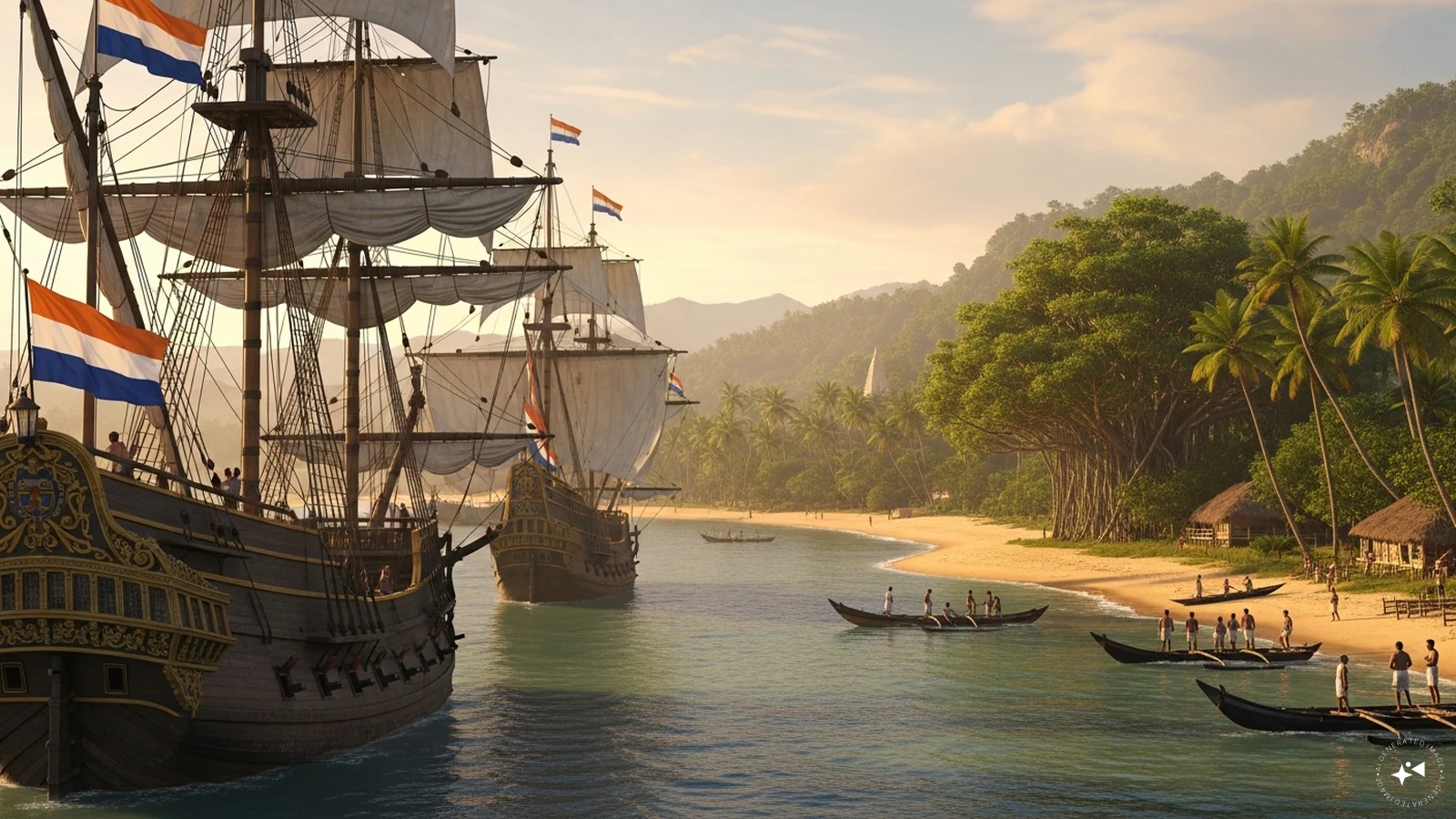Copyright news18

Could Bali have survived as a sovereign Hindu kingdom, like Nepal was until 2008? The island became part of the expanding Dutch empire in the East Indies only in the first decades of the 20th century. Previously, it had maintained its Hindu sovereignty, even as Hindu rule in neighbouring Java had collapsed in the 1520s as a result of dissension caused in the ruling family after many of its members had converted to Islam. Java, prior to its political capitulation to Islam, was the seat of the powerful Hindu maritime empire, viz, Majapahit, in existence since the late 13th century. The Hindu king, informs RC Majumdar (1944), left Java and took shelter in Bali, then a dependency of Majapahit, about 1522 (Hindu Colonies in the Far East, P69). A large number of Javanese, says RC Majumdar, found “migration to Bali as the only means to save their religion and culture”. Bali thus became the last stronghold of Indo-Javanese culture. The subsequent history of Bali was merely a continuation of Majapahit. It preserved from oblivion “much of it which Java herself lost as a result of conversion to the Muhammedan faith” (Ibid, P71). The eclipse of the Hindu sovereignty, though not its religion and culture, happened in the early 20th century in the age of Dutch colonialism. The end was not only pathetic but also dramatic. Whereas the Balinese had acknowledged nominal Dutch suzerainty in 1839, it took many naval expeditions to subdue the island, divided into several autonomous states. In 1908, as historian RC Majumdar informs, the last heir of the Emperors of Majapahit, having found himself hopelessly besieged in his palace by the Dutch, refused with scorn the offer to save his life and family by unconditional surrender. Remembering the “proud examples of his Kshatriya forefathers, he seized his sacred sword, and bodily rushed out with his nobles, wives and children to meet an end worthy of his race” (Ibid P72). Indonesia: A Country Study (2011), of the series produced by the Federal Research Division, Library of Congress, carries further sensational details. It says that in Badung, Tabnan, Klungkung, and others, the rajas and their families and followers sacrificed themselves in dramatic frontal assaults on KNIL (Royal Dutch East Indies Army) guns. These puputan, or ritual suicides, killed hundreds of men, women and children, decimating aristocracy, and obliterating all meaningful further resistance to the expansion of colonial rule in Bali (P34). Dutch rule soon reached its final extent in the East Indies, encompassing far-flung islands like Kai (in south eastern Maluku) and Papua (on the island of New Guinea). These puputan, or ritual suicides, might appear a shocking chapter in the history of colonial rule in the East Indies (now Indonesia). The Dutch had developed a secure footing in Java and the East Indies since the first half of the 17th century. Previously, they had arrived on India’s Malabar Coast in the late 16th century, almost a hundred years later than the Portuguese Vasco da Gama. Gradually, the Dutch expanded their footprints in the East Indies, Ceylon and the Malabar Coast, ending the Portuguese domination in the Indian Ocean. The Portuguese authority got confined to Goa, Daman, Diu on the Konkan Coast in India and Macau in China, etc. Historian and diplomat KM Panikkar (1931) says that, unlike the Portuguese, the Dutch never claimed that they had conquered India or any part of it. While the Portuguese had appointed governors and viceroys to govern the East, from the time of Vasco da Gama, the Dutch were satisfied with commandeurs and factors (Malabar and the Dutch, P168). Historian Kalikinkar Datta (1948) informs that, like the English and the French, the Dutch had considerable commercial transactions in India. In Bengal subah (including Bihar and Odisha), the Dutch had important centres of commerce such as Pipli, Balasore, Patna, Futwah, Dacca, Maldah, Kalikapur near Cassimbazar, Chinsura and Baranagore, and Jugdea or Luckipur, etc (The Dutch in Bengal and Bihar 1740-1825, P1-2). The Dutch relationship with the English East India Company was one of both competition and cooperation. In Bengal, for instance, they had disregarded the stern warning of Siraj-ud-Daulah in 1756-57 to help him against the British. However, the British victory at Plassey made them extremely jealous. The Dutch tried to import troops from the East Indies to chastise the British in 1759. However, in the Battle of Biderra, near Chinsura on November 25, 1759, they found their fleet utterly routed by the British within a span of half an hour. In those days, Hooghly, a branch of the Ganga, was a wide river where European warships could operate with felicity, before geological changes reduced the volume of water flow within fifty years. Finally, by the 1820s, the Dutch realised that they had become merely an appendage in India, while the British had become the masters. Whereas the British had already secured the lion’s share of India, they further threatened Dutch colonial interests in Southeast Asia. They thus thought it better to mutually exchange their possession to end this situation of cross-holdings. This was formalised through the Treaty of London (March 17, 1824) between the two royal governments. By 1825, or exactly two hundred years ago, the Dutch moved lock, stock and barrel out of India to concentrate wholly on the East Indies. They left behind their relics like forts, churches, warehouses and private residences. In 1897, Alexander Rea, the then Superintendent of the Archaeological Survey of Madras, published a list of monumental remains of Dutch Settlements in the Madras Presidency. The compass of these remains extended from the Coromandel Coast to the Malabar Coast in the peninsula. The places they covered were Bimlipatnam, Calicut, Cannanore, Chetwai (Chettuva), Cochin, Conimere (Kunimedu), Cuddalore, Jaganadhapuram, Masulipatnam, Narsapur, Negapatnam (Nagapattinam), Palakol (Pallakollu), Pamban, Pulicat, Tuticorin and Nellore coast, etc. A number of the constructions were in a state of ruin, whereas some others were still in use under British rule. “The most interesting remains”, observes Rea, “are their tombs. The care and artistic skill bestowed on them, bear evidence to the reverence of the Dutch for their dead”. Rea, himself a British archaeologist, says (in a tone derisive to his own government), that the patient labour bestowed on these monuments, and the imperishable nature of their construction, were in marked contrast to the unsubstantial commonplace brick erections of the English in India (The Monumental Remains of the Dutch East India Company in the Presidency of Madras 1664-1824, P.44) People of India have no memory of the Dutch colonial presence. This columnist, born in Chandernagore, formerly a French settlement in Bengal, had grown up hearing about the Dutch settlement in the neighbouring township of Chinsurah-Hooghly. In Bengali, they are called Olandaz, a corrupted form of Hollanders. The artillery wall of Fort Gustavus, a sign of Dutch power, is now a part of Hooghly Madrasa. There is a Dutch cemetery, protected as a national monument of the Archaeological Survey of India. However, whereas French rule in India, though they were mere toeholds, survived the British departure from the subcontinent, the Dutch settlements, apart from being isolated spots, disappeared two centuries ago. It would be wrong to credit the British entirely for the eclipse of Dutch power in India. The real credit should go to a Hindu king of Kerala in the mid-18th century, viz, Raja Marthanda Varma (r1729-58) of Travancore. When the Dutch arrived on the Malabar Coast in the late 16th century, only Cochin wielded the real power, whereas Travancore was one of the many principalities (reportedly 46) in Kerala. However, the ascent of Travancore under Raja Marthanda Varma in the 1730s unnerved the Dutch, who were also feeling the pressure of English maritime and military power. In 1740, the Dutch threatened Marthanda Varma with invasion. The Raja scornfully stated, informs PC Alexander (not to be confused with the famous civil servant and governor), that he himself had been thinking some day of invading Europe with his canoes and fishermen (The Dutch in Malabar, P48). In January 1741, the Dutch did outrage Travancore’s territory by occupying Colachel in the midst of a political crisis. The Dutch, says PC Alexander, planned to seize the whole country from Colachel to Cape Comorin (Kanyakumari) and make it a Dutch province. They were even contemplating an attack on Raja’s palace at Padmanabhapuram. Though the bulk of Travancore’s army at that time was busy on the northern frontier, the king displayed conspicuous ability to handle the danger in the south. Over the ensuing months, the army under Rama Iyer was moved from north to south, a Nair force was raised, and negotiations were opened with the French, who promised to help the king against the Dutch. Thus, in the famous battle of Colachel— which took place on August 10, 1741 (July 31 according to the Julian Calendar)— Raja Marthanda Varma took the overall command of the operations on the battlefield. Rama Iyer’s troops broke through the Dutch line and threw their army into a great confusion. Even as the Dutch retreated to their fort, PC Alexander informs, 24 of them were taken prisoner and sent to Udaygiri in Kanyakumari district. The Dutch fortress was besieged, forcing the Dutch to sail away to Cochin (The Dutch in Malabar, P.50). The Battle of Colachel passed into legends. It was a rare occasion when an Indian potentate had taken on European power head-on and defeated them. A painting showing Eustachius De Lannoy, the Dutch naval commander, bowing down on his knees to Raja Marthanda Varma, with the sea in the background. The Madras Regiment of the Indian Army still celebrates the day every year. However, it apparently celebrates the day on July 31 (as per the Julian Calendar, which the British were using until 1752) rather than on August 10. Raja Marthanda Varma displayed not only his valour but also kingly sagacity at Colachel. He extended kind treatment to the Dutch soldiers and enlisted them in his army in a bid to modernise it on European lines. De Lannoy, as PC Alexander informs, later came to be known as Valia Kappithan (Great Captain), constructed forts, and reorganised the whole Travancore army on a European model, giving it a smart appearance and raising its efficiency to a very high order (Ibid, P50) The writer is author of the book ‘The Microphone Men: How Orators Created a Modern India’ (2019) and an independent researcher based in New Delhi. Views expressed in the above piece are personal and solely those of the author. They do not necessarily reflect News18’s views.



